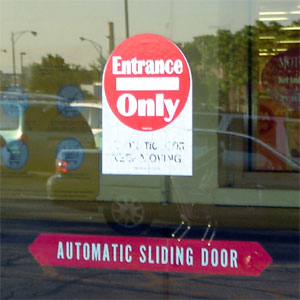To WWW Or Not To WWW
Do you need to include the “www.” when displaying a URL? This was a recent topic on Seth Godin’s blog, and reading various other blog posts and articles on the topic, the general consensus is you do not need to include the www-dot before a domain name. When someone sees a domain name all by itself, they assume it’s a Web site. But does it mean that every time you enter just a domain name you will get the Web site?
Unfortunately the answer to this is no. And it has nothing to do with marketing or how much room you have to display a domain name. It has to do with Web server and network configuration.
Here’s an example of where leaving out the www-dot will not show you the Web site. Berkshire Hathaway is the multi-billion dollar empire of Warren Buffett. Though he hangs out will his fellow top-tier billionaire Bill Gates, he shuns technology whenever possible. Berkshire Hathaway does have a Web site, albeit extremely simple. If you browse to it at http://www.berkshirehathaway.com you will be presented with the Web site. However, leave off the www-dot going to http://berkshirehathaway.com and you get an error.
The www-dot in question is called a subdomain, and is used to identify various types of servers on a domain. If you have ever configured Outlook or an email program with an email server, you probably entered a server name beginning with mail-dot. As a result, using – and not using – the www-dot subdomain needs to be configured. It needs to be addressed within the network domain configuration as well as the Web server or servers. It must be configured and tested properly, as leaving off the www-dot can be configured to take you to an altogether different Web site!
Why not take this time to check your own Web sites and blogs to see if they pass the test of leaving off the www-dot. And while you’re at it, check your vendors, partners and even competitors. Good luck telling them if doesn’t work – I emailed Berkshire Hathaway over a month ago when I first saw this problem, and it still exists.
Did you enjoy reading this? You are welcome to subscribe to The Hot Iron by RSS feed or by email.
SSL Certificates Are Not Just For eCommerce
 Security is one of the keys to having a successful eCommerce Web site. Forming a trusted relationship with your customer is important. Having great products is somewhere high on the list too, but I digress. A key component to eCommerce security is the SSL certificate. Without getting into the technical details, it verifies who you are doing business with online, and that any information passed from the client’s browser to the Web server is secured.
Security is one of the keys to having a successful eCommerce Web site. Forming a trusted relationship with your customer is important. Having great products is somewhere high on the list too, but I digress. A key component to eCommerce security is the SSL certificate. Without getting into the technical details, it verifies who you are doing business with online, and that any information passed from the client’s browser to the Web server is secured.
For many people, owners of Web sites and those who develop them, eCommerce is the only use for SSL certificates considered. However, in a time of increased identity theft and fraud, an expanded use of SSL certificates, and thus higher security, should be utilized for Web sites that may not engage in eCommerce, but capture information.
Take the example of the common “contact us” form. It consists of form fields asking for identifying information (e.g. name, email, phone) and commonly has a text box where the Web visitor can enter any text. The key word here is “any.” As the level of sophistication of Web users vary, someone may enter sensitive information on such a contact form, including a username/password combination or even a social security number. There is no way to know what they will enter and submit to you until they do so. Where you can put a message on a Web form strongly urging people not to enter sensitive information, this still does not prevent it from happening.
The contact form on the Dunkirk Systems, LLC Web site is secured with an SSL certificate. I did this for the reason above, plus as it is a service we offer, it in itself is a showcase example. In the past we delivered a similar solution for a mortgage company’s contact form, as they could get people submitting all sorts of sensitive information via the form, including social security numbers.
Take a look at your Web site, and take a look what people are submitting to you via the Web site. Adding a little extra security may make your normal business transactions into win-win situations.
Did you enjoy reading this? You are welcome to subscribe to The Hot Iron by RSS feed or by email.
6 Questions with Tim Courtney
 1 - Who are you, and what are you doing here?
1 - Who are you, and what are you doing here?
I'm Tim Courtney, a Chicago-area (Wheaton) native who "grew up" on the Internet. I get excited when I see technology enabling people to connect in the real world on deeper, more diverse, and more meaningful levels.
Thus, I'm very interested in social technology and online communities that are changing the way we self-identify, select our associations, and interact in a face-to-face world. These trends are instituting large cultural shifts and we're just beginning to see the potential and the results.
To answer what I am doing; a few things. Most immediately, I'm co-organizing SocialDevCampChicago with Andy Angelos coming up on August 9th. It's a BarCamp-style unconference for people passionate about social networks, web applications, platform development, new media, identity management, and other related topics.
Through my employer XNet, I co-host Silicon Prairie Social; a popular tech networking event in the western suburbs. XNet is a a Lisle, IL-based boutique data center (colocation, dedicated, and managed servers), where I work and am responsible for marketing. We help frazzled IT people sleep at night, knowing their critical systems are in the hands of experts who are committed to the continuity, security, and growth of their businesses.
 2 - You certainly are connecting people! What is an "unconference" either in general or how you see it and how you see SocialDevCampChicago unfolding?
2 - You certainly are connecting people! What is an "unconference" either in general or how you see it and how you see SocialDevCampChicago unfolding?
An "unconference" is a conference where the attendees drive the discussion, and many times the discussion topics are decided at the event itself. SocialDevCamp Chicago is somewhat based on the BarCamp concept for unconferences. Here, we're allowing attendees to sign up for time slots for their presentations and panels, provided they fit one of two tracks: a Business & Culture track and a Technical track. We're also providing a Coding Lounge for people to relax and chat or code together.
Our goal with SocialDevCamp Chicago is to see people come away with a better grasp of the technologies and platforms driving web trends over the next few years, and be able to apply that knowledge directly to their pursuits; businesses, communities, causes, etc. We also hope attendees will come away with a better understanding of how social technologies are changing how people relate to and communicate with each other in their face-to-face relationships.
3 - Are you finding people are seeking to meet people to get to know more in person, or just more people to communicate with online?
With SocialDevCamp, I get the feeling that people want to come together in person and talk about their shared interest. Of the people I've talked to who are attending, they're coming to learn more about development and trends, while meeting people who are likeminded. I get the feeling they want to transfer online connections into in-person collaboration and relationships -- whether as partners, collaborators, customers, users, or even friends.
4 - What personal goals do you have for SocialDevCamp?
For several months, I've been thinking through how to apply the essential features behind social networks to niche interests such as my own interest in LEGO. I believe hobbies and interests can flourish if the online experience for users becomes an extension of everyday online activities. I'm looking to share some of these thoughts at SocialDevCamp and solicit feedback from other thinkers in the space.
5 - What have you been able to apply from your leading these events to your position at XNet?
SocialDevCampChicago really stems out of a personal interest in development of social technology. The three Silicon Prairie Social events, however, have had a direct tie-in to XNet. Arthur and I have used the Social events to build up the suburban technology community like many of the events in the city have done for downtown. As a result of rubbing shoulders with other service providers, integrators, and consultants at the Silicon Prairie Social, I've been able to take knowledge and insight of emerging trends back to XNet and shape the direction of what we'll offer in the future. We've also seen some promising partnerships begin to emerge from our involvement there.
6 - What is one question I did not ask, and what is its answer?
As a technology evangelist, what is your key focus?
When talking with others about technologies -- social or otherwise -- I really focus on design and usability. I've worked with developer groups over the years in open-source environments and seen the focus be on the software and the features. People use computers to accomplish personal and social ends, not to interact with technology out of its own right. Technology should be transparent if a platform or application is to reach as many users as possible. If you're looking to spread your idea via the web or via a social platform, make the interface intuitive to the user -- not to you or following a set of prescribed rules. For a better worded outline of the above, see this blog post by Aza Raskin summarizing the "Not the User's Fault" manifesto.
Did you enjoy reading this? You are welcome to subscribe to The Hot Iron by RSS feed or by email.
Usability and Familiar Symbols
 A large part of usability is the ease for how anything – from a Web site to a coffee maker and beyond – can be, well, used. Familiarity can have a significant impact on usability. If someone used something elsewhere that looks familiar in something else, they may be able to use this new item here.
A large part of usability is the ease for how anything – from a Web site to a coffee maker and beyond – can be, well, used. Familiarity can have a significant impact on usability. If someone used something elsewhere that looks familiar in something else, they may be able to use this new item here.
I have experienced this first hand when traveling abroad. A couple of years ago my lovely wife and I visited Denmark, and this was the first time I did a fair amount of driving outside of the US. Where I did not speak the language, I was able to get around on the roads as the international driving signs and symbols were familiar to me. Even if the Danish words were not familiar, the overall symbol’s shape and color were, and as a result I knew what to do, and did not get into an accident.
This came to mind recently on a trip to the Babies R Us store in Chicago. On the front entrance is a sign that reads “Entrance Only” however the words are inside of the international symbol for “do not enter” as shown in the accompanying photo The first time I went to the store, I paused for a moment as I got a mixed signal – the sign reads enter, but the symbol says not to. As many stores employ the green enter and red do not enter signs, my reaction was not unusual. Realizing this was the only way in, I proceeded to enter. Looking back as I did, I was not the only person to proceed with caution upon approaching this door.
Where I don’t design retail stores, I design Web sites. The adherence to consistency and commonly accepted standards is vital to the success of a Web site. If a Web visitor doesn’t know they should click on something, they won’t. Hopefully this is not referring to a “buy” button on a Web page. The above-mentioned sign may not have turned someone completely away from shopping at Babies R Us, but that was probably due more to the fact they drove to the store and eventually figured they could enter. With a Web site, you may not have that luxury of someone being that persistent, and they will seek a Web site that is more familiar to them.
Did you enjoy reading this? You are welcome to subscribe to The Hot Iron by RSS feed or by email.
My Take-Aways From The Book e-Preneur
In my takeaways on the book The Venture Cafe I said in business you cannot truly go it alone. But what if you took it to the extreme, where the ideas for what your business does came from other people, namely the same people you are trying to sell to? This is the premise of the book e-Preneur, subtitled “From Wall Street to Wiki: Succeeding as a Crowdpreneur in the New Virtual Marketplace.”
A crowdpreneur, as defined by the author Richard Goossen, is, “an individual or organization that uses the strategy of online crowd empowerment in its various forms (collective intelligence, mass collaboration, crowdsourcing & others) in the pursuit of an entrepreneurial venture.” In other words, your business is solely about the ideas from others. Crowdsourcing, as I have digested it, is making an open call for ideas. An example of a crowdpreneur often cited is Chicago’s Threadless, a t-shirt company where ideas are submitted by the community through their Web site, who vote on what shirt designs will eventually be sold.
To many this is not only a new idea but one they probably would never consider. How can you give control over what your business does to others? However if you have some curiosity on the topic, this may be a read for you. Even though my own business Dunkirk Systems, LLC would be considered traditional in comparison to a crowdpreneurial business, I did have takeaways from this book.
My greatest take away is to keep in close contact with your customers. Business owners of all sizes can easily lose focus of their business and the service they offer to their customers. As a small businessperson, the input and ideas from my partners and clients are critical to the success of my business. On the other extreme is the airline industry, who plainly doesn’t give a damn about their customers. Input can sometimes be a distraction, but managed properly it can be a vital source for ideas and as a result increased business.
Another take away is that there is no shortage of ideas for running a business. Advances in technology, including Internet technologies labeled as “Web 2.0,” have enabled companies to do many great things, including crowdsourcing and being crowdpreneurial. Just think back a few years for many of the services and Web sites (e.g. YouTube) were merely good ideas in someone’s head. By keeping an open mind and being able to adapt and change as needed, companies can either stay ahead of the game, or survive in tough economic times.
E-Preneur takes the reader through 5 steps to create a crowdpreneurial venture, from the original concept to funding it. Throughout the book there are many lists, though if they were broken out more as tabular lists would have been more helpful in organizing your thoughts as you read it. The book closes with some basic business start-up concepts that, if you are already at this point, you may already have down. Where many books have a type or two, a glaring error was in citing name of the chairman of Cisco Systems as John Cisco instead of John Chambers! All things considered, if you are looking for ideas or a different perspective on business, e-Preneur is a good and encouraging read.
Did you enjoy reading this? You are welcome to subscribe to The Hot Iron by RSS feed or by email.

